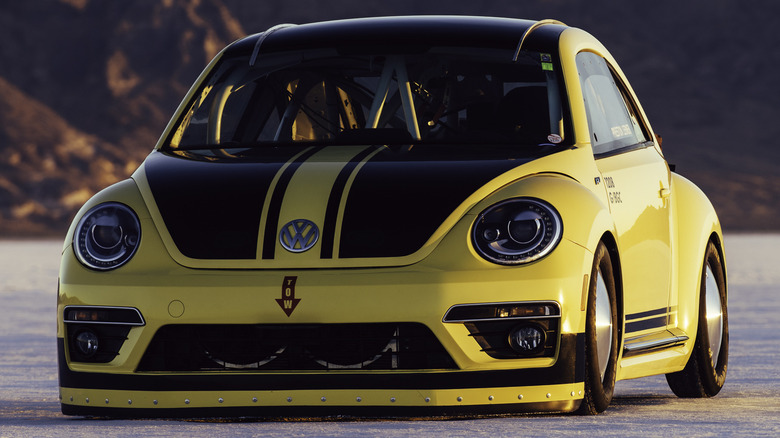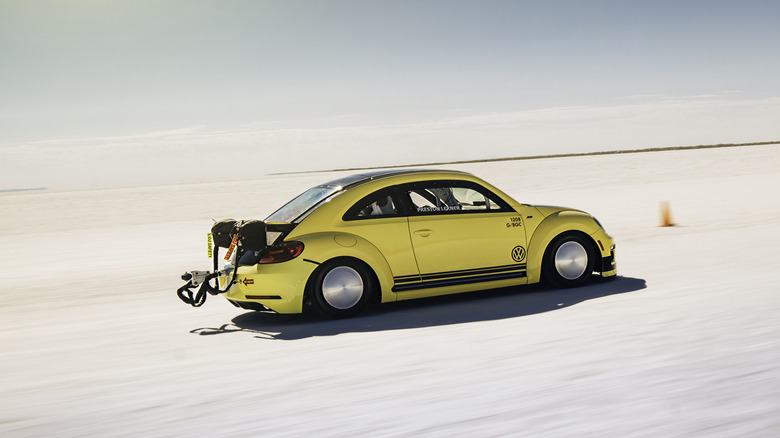Flying Bug: The Worlds Fastest Volkswagen Beetle
In the 2010s, Volkswagen was having trouble selling its standard third-generation Beetle, a problem that ultimately led to the car being discontinued entirely. The company decided it needed to convince people of the power of the Beetle to get them to buy in. However, this proved easier said than done.
When you think of the Volkswagen Beetle, the first word that comes to your mind probably isn't fast. To remedy this, Volkswagen hatched a new plan to crush the gas coupe class record top speed on the famous Bonneville Salt Flats in Wendover, Utah. The Salt Flats are often used for stunts like this, as its 12-mile-long flat surface makes for the perfect place to break land speed records.
To complete the task, Volkswagen needed an improved version of the Beetle. The company brought Tom Habrzyk, a veteran Salt Flats speed racer, to oversee the build. To break the record, the vehicle needed to reach a land speed record of over 200 mph on the Salt Flats. However, this feat would prove to be no easy task.
Under the hood
Due to the rules set out by the Southern California Timing Association (SCTA), the team could not make major changes to the car's exterior. However, that wasn't the case for what was under the hood. The vehicle started its life as a stock R-Line Beetle coupe. The R-Line coupe has a six-speed transmission and an EA888 turbocharged and direct-injection 2.0-liter TSI engine, which lets it go 0 to 60 mph in 6.6 seconds, but it needed to go much faster than that to break the record.
Among the modifications were two turbochargers, forged pistons and conrods, a modified powertrain, and a new suspension system. After it was finished, the LSR went from producing 210 hp to 543 hp, in addition to making 421 lb-ft of torque at the wheels. Thus, the fastest Beetle ever was born. Other modifications included a roll cage, racing seat and harness, and a fire suppression system. It also had special Salt Flats tires and a limited-slip differential to give it better traction on the unique surface.
Almost breaking the record
Automotive journalist Preston Lerner was asked to drive the souped-up Beetle. The first two attempts to break the gas coupe class record were made in 2014, but those resulted in failure due to problems with the vehicle. Extensive repairs paired with bad weather meant the team couldn't return to the Salt Flats for another attempt until 2016.
However, when Lerner gave it another go he managed to reach speeds of 205 mph on their first run. Unfortunately, there was an issue with the water pump for the second run, resulting in the record not being official for the flying mile. The vehicle lived on, though, as Thomas Geiger would go on to hit 200 mph in Southern California on the El Mirage course. Despite the technical failure, Volkswagen called the test a success. In a release after the event Volkswagen explained that "the Beetle is not the most aerodynamic car in our portfolio, so running 205 mph is a testament to the power."
The LSR is not the only fast Beetle out there. The Beetle RSi, for example, has a 3.2-liter V-6 that produces 221 horsepower that can go from 0 to 60 in 6.18 seconds. These vehicles are rare, though, and sometimes cost more than a Porsche. The Beetle can also be found on the rallycross trail, with one special Beetle boasting an impressive 560 hp. Still, no Bug that came before or after the LSR can compete with its incredible speed.


